Conditions in the Midwest are ideal for Bass fishing, and Table Rock Lake in southwestern Missouri is no exception. It rates highly on Bassmaster’s list of the top 100 US lakes, and the waters offer enough action to draw in sponsored competitions like the 11th annual Toyota Bonus Event in 2022.

This flood-control reservoir has produced state-record catches for Spotted Bass, White Bass, and Paddlefish since the late 1950s. With over 45,000 surface acres of water and 745 miles of shoreline, Table Rock Lake offers plenty of contour, depth, and structure changes for you to fish.
Yet Bass fishing here isn’t as simple as it might seem at first glance. Let’s learn everything you need to know about where the Bass are, what their seasonal activity looks like, and how you can catch them at Table Rock Lake.
Which types of Bass are in Table Rock Lake?

Chances are you’ll run across several species of fish on the water here, but Black Bass are the kings of Table Rock Lake. Among this family of species, the reservoir holds sizeable Largemouth, Smallmouth, and Spotted Bass populations.
Research by the Missouri Department of Conservation shows that Largemouth in the lake can reach at least 15 inches within four years. Electrofishing surveys in recent years show 27 percent of Largemouth Bass here are 15 inches or longer, with lots of Spotted Bass in the 11–14 inch range. This research also revealed plenty of sizable Smallmouth Bass in the lake as well.
Table Rock Lake Bass Seasons and Best Practices
The primary tributaries for Table Rock Lake are spring-fed, meaning the water here is translucent compared to other Missouri waterways. Many locals favor fluorocarbon lines in the 6–8 pound range for presentation, along with lighter rods and reels.

Spring means that the water warms up, drawing Bass into shallower depths as they prepare to spawn. The James and Kings Rivers warm before the rest of the waterways and get the earliest attention from anglers. Smallmouth and Spotted Bass hang above rock cover at about 15 feet from the mid-lake to dam area. Largemouth will come to water 8 feet or less and look for wood cover.
At this time of year, target Bass as they spawn in the shallows using topwater lures like buzzbaits and poppers. “Walking the dog” or sporadic retrievals can generate reactionary strikes and pull fish from their ambush points.
When summer heats the water post-spawn, the fish move to colder, oxygen-rich waters away from the shoreline. Most anglers pull out their fishfinders and look for Bass hugging the sides of points in 30–70 feet of water. An exception to this might be Largemouth hunting the colored waters of the two rivers mentioned for spring fishing. Look for submerged points, brush, standing timber, and drops into channels here.
Smallmouth and Spotted Bass are fishable in deeper water by dropping jigs from above and skipping plastics off the bottom. Hit Largemouths with Berkley worms and deep-diving crankbaits in the stained waters around points and channel drops in the river tributaries.

When the nights begin to cool during fall, you’ll notice the fish moving away from deeper waters as they follow bait fish into shallow depths in coves and feeder creeks. These areas become dense with fish and make for the best Bass fishing outside of spring on Table Rock Lake.
At this time of year, you’ll want to locate the bait fish heading into the creeks. The Bass will follow. Hit them with crankbaits, spinnerbaits, or football jigs near cover and rock piles used for ambush points.
Winter doesn’t mean it gets slow on the lake. Not at all. Smallmouth and Spotted Bass follow Threadfin into creeks and rivers. Locate the bait fish, and you’ll find plenty of Bass nearby. Use your sonar equipment to make it easy – they like to suspend over water as deep as 150 feet. But you’ll generally find Largemouth, Smallmouth, and Spotted Bass 10–35 feet deep over the ends of bluffs and points with deep water escape routes.
Where to Find Bass on Table Rock Lake
When it comes to Bass fishing, we all know that getting out there simply won’t cut it. Location is everything. Here are the key places known for Bass on Table Rock Lake:
Smallmouth Bass
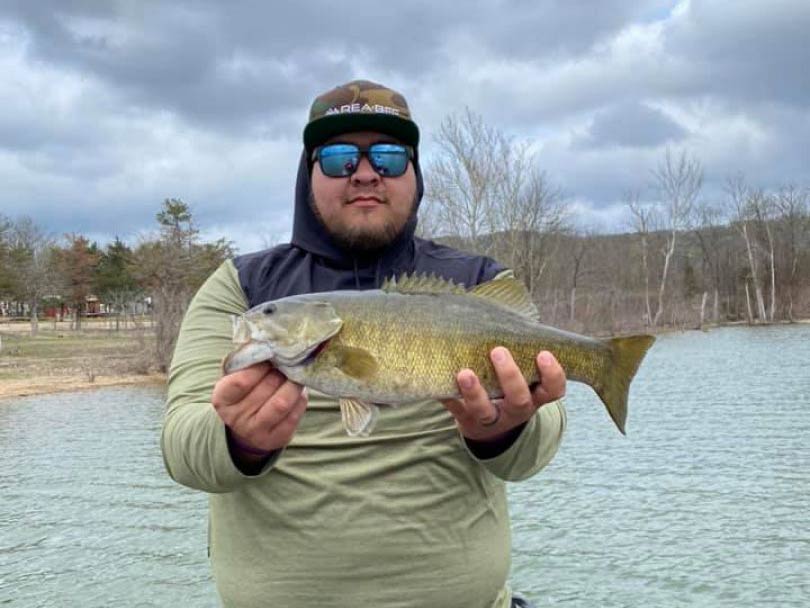
If you’re not hitting the coves around Indian Point (discussed below), you might find a perfect storm of conditions at the Peninsula Lookout point north of the dam. You have drop-offs to deeper water and submerged structures that Smallmouths favor. A couple of coves north of here provide conditions that attract these fish, and the nearby Moonshine Beach boat ramp offers a close launching point.
Indian Point is highly developed and well-liked for a reason. Locals call it the “Eye of the Needle,” but we’ll call it “Cove Paradise.” Any coves along the eastern or western side of the point offer excellent fishing opportunities, especially for Smallmouths. You can hit the covers from Indian Point to the dam, and stay busy with fish all day.
Stop in the marina to hear the latest buzz about fishing here and stock up on what the fish are striking. There are also several lodging locations nearby, such as the Indian Point campground and several resorts.
Largemouth Bass
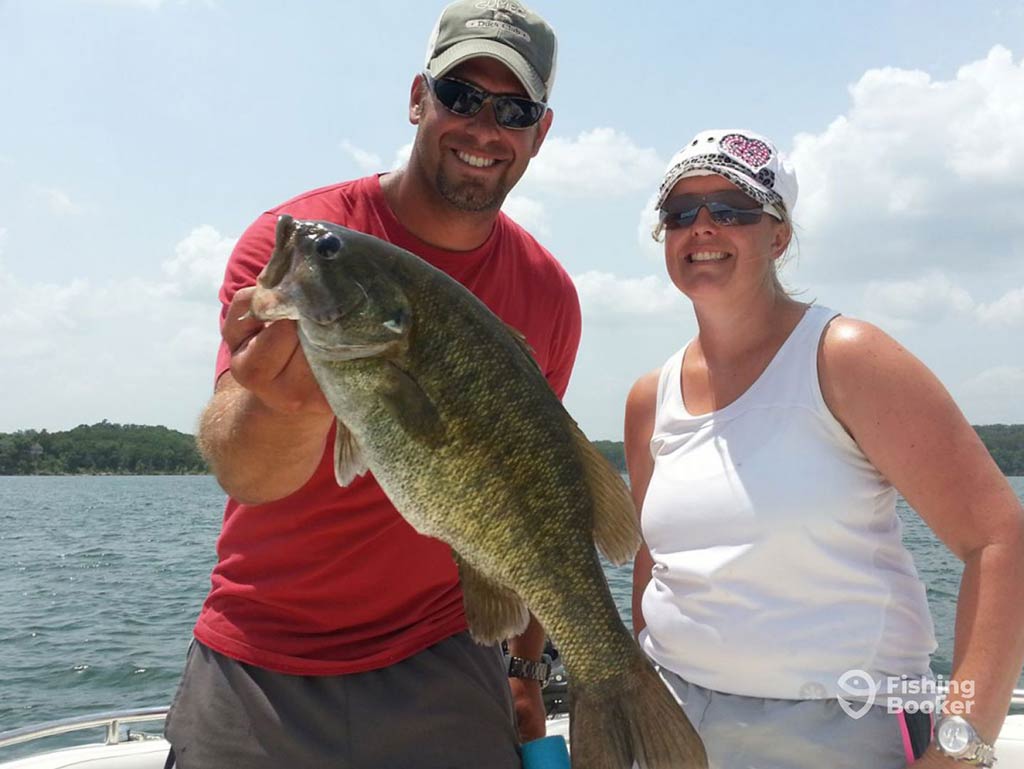
When it comes to Table Rock Lake, the main tributaries (the James, Kings, and White Rivers) are Largemouth Bass havens, especially in spring and fall. If you just choose one, the James River should be your destination.
It’s the second-quickest to warm in spring, attracting even lunkers looking for a spawning site. They tend to stay here in summer to use the abundant cover and channel drop-offs. The fall season brings in shad, which draws Largemouths back into shallow waters of 8–10 feet. The only time the action on the James River slows is during winter.
You can also narrow your focus more by concentrating on the Aunts Creek area. A boat ramp near the Aunts Creek campground lets you move up and down the river by boat, and you can find plenty of shoreline to fish from.
Shore Fishing

While fishing from a boat is ideal on a body of water this size, there’s also ample shoreline to work. Many anglers select locations with developed pathways, like Table Rock State Park south of the dam. Use the Lakeshore Trail to find access to the water.
Old 86 Park offers access to the Long Creek arm, a point, and a cove you can target from land. The public use area at Indian Point can put you by the shoreline, and it’s close to fishing provisions and rentals at the marina. Aunt’s Creek on the east side of the James River is another popular shore access point that can be productive.
Other Table Rock Lake Fish Species
If you want to try something outside of the big three Bass species mentioned above, you can always target Table Rock Lake’s White Bass. Look for them in tributaries in March or gravel beds 25–50 feet deep during the warmer months.
Quality Bluegill fishing can also yield specimens in the 7–9 inch range. Anglers looking for the best time to shoot for Bluegill should come between the end of May and early July. These fish like to swim in water depths between 10 and 20 feet. Look for them in areas with gravel substrates, along submerged points, and near pockets. Light gear with live crickets or worms will keep you busy.
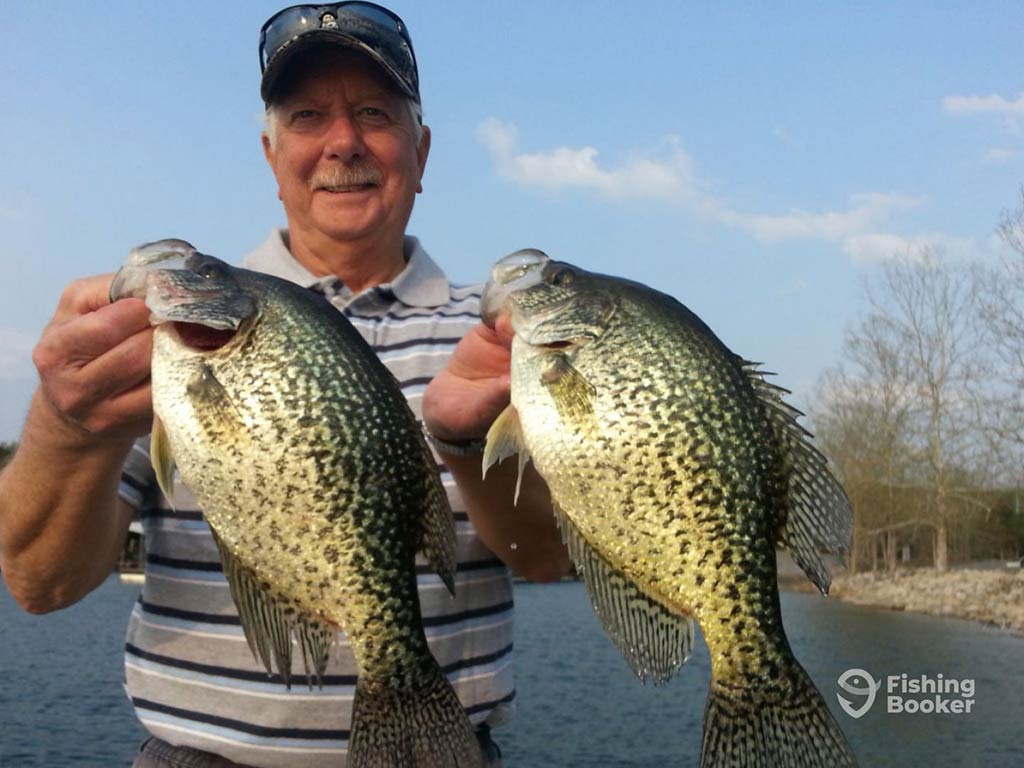
Crappie fishing is popular year-round, but spring and fall represent peak seasons. You’ll find Black and White Crappie here, and fishing the James, Kings, and Long Creek tributaries will hold the densest populations. Brush piles and submerged wood are ideal target structures for these fish. Speaking of Panfish, you may also run into some Redear Sunfish if you fish the Upper White River’s arm. Half of these fish pulled from here are over nine inches long.
You could also stumble across some Rock Bass in areas you target Smallmouths. “Goggle Eyes” will congregate near shrubs and rockpiles.
Channel and Flathead Catfish have decent population sizes in Table Rock Lake but receive little fishing pressure. If you’re looking for Channels, try the rivers’ arms. Meanwhile, Flatheads gravitate towards clear sections of the main lake. Late spring and early summer are peak Catfish seasons on the lake, with anglers using jug lines, set lines, and rod and reel.
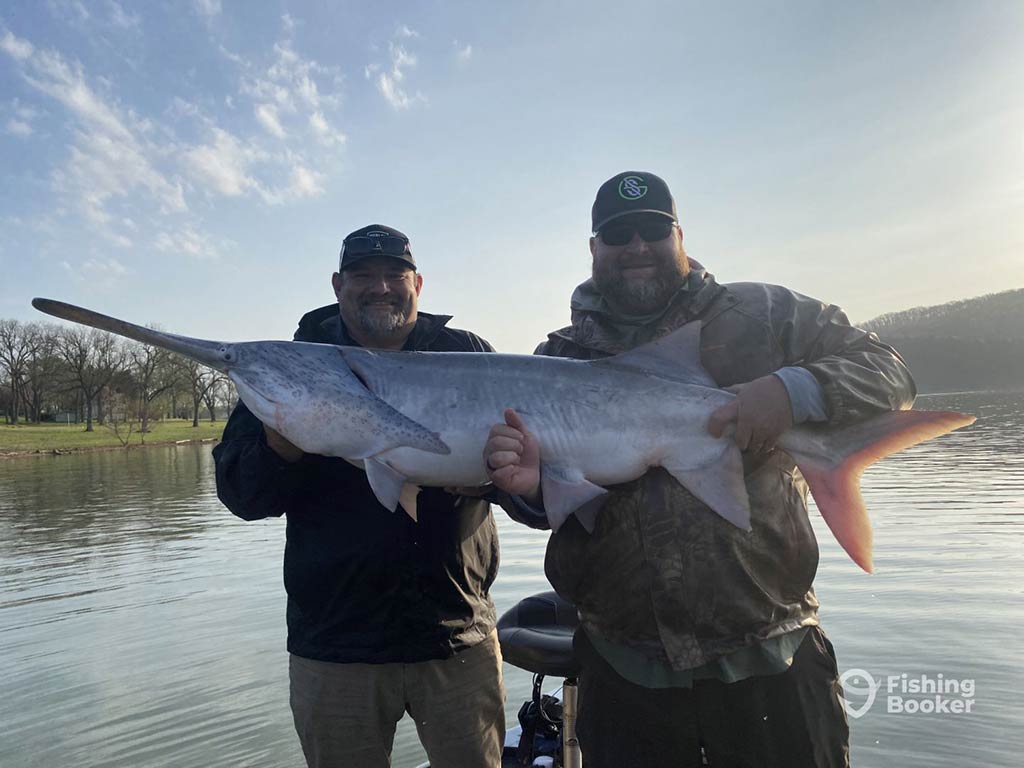
And that’s not all. There are lots of nice-sized Paddlefish here, and you should look for them in the upper reaches of the James River Arm above Cape Fair in the spring. Just beware that the length of spawning runs depends on the water level. Meanwhile, you can target spring Walleye near the dam or the James, Kings, and White Rivers’ arms. They’ll head to deeper water in the summer, so troll deeply submerged points and channel swings at this time of year.
Table Rock Lake Bass Fishing Rules and Regulations
Missouri residents between the ages of 16 and 64 must purchase a resident fishing permit. Non-residents 16 and older must purchase a non-resident fishing permit to fish Table Rock Lake. You can find more details on the Missouri Department of Conservation’s website.

Parts of this waterway sit within Arkansas, so you’ll need a White River Border Permit with your Missouri fishing permit or an Arkansas fishing license. Information on those licenses is available at the Arkansas Game and Fish Commission’s site.
You can find species information that gets updated annually, including acceptable catching methods, bag limits, seasons, and information on any other permits online, too. Special Table Rock Lake daily limits include two Paddlefish by snag, snare, or grab.
Catfish are limited to 10, while there’s a 15 Crappie fish limit. Black Bass must be 15 inches, Crappie 10 inches, and Sauger or Walleye 18 inches. Paddlefish must be at least 34 inches from the eye to the fork of the tail for you to keep.
Table Rock Lake Fishing FAQs
Bass Fishing at Table Rock Lake: An Institution
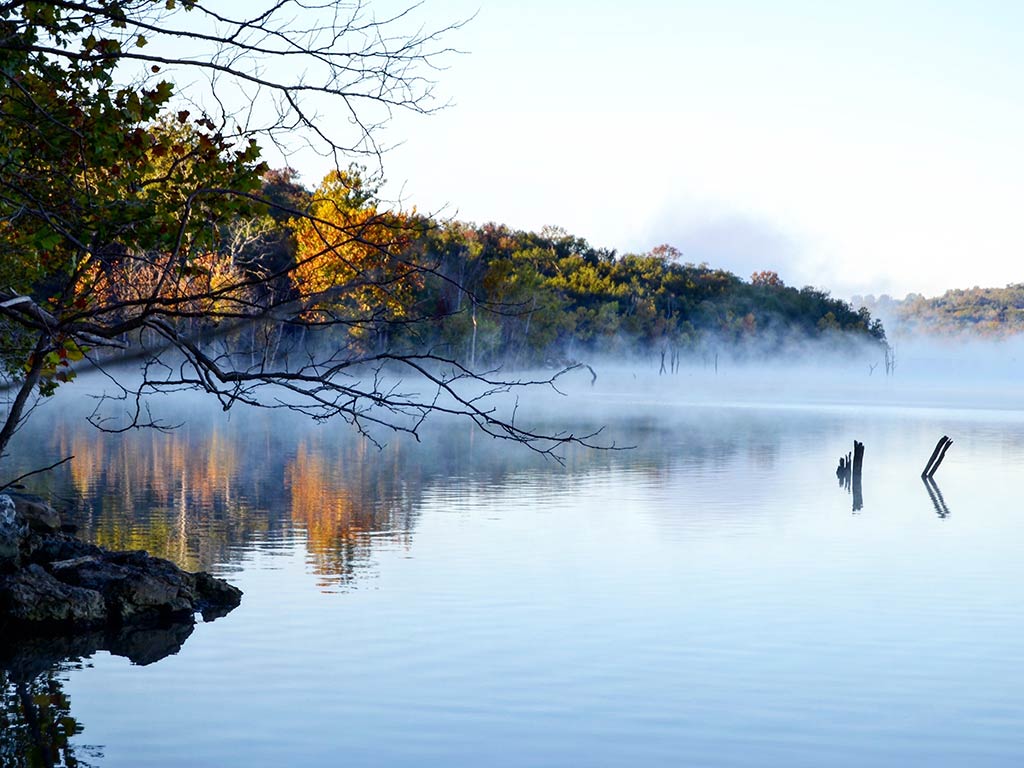
With healthy populations of several Bass species, lots of water structure, and ideal growing conditions, Table Rock Lake should be on your must-visit list. From sit-back-and-enjoy charters to hiking a footpath in an isolated cove, you can craft an exciting Bass fishing experience on these waters. Get your paperwork in order and head to one of the most popular Bass fisheries in southwestern Missouri. Here’s to hoping that the next one is a wall hanger!
Have you ever been Bass fishing at Table Rock Lake? How was your experience? We’d love to hear from you in the comments below!
The post Table Rock Lake Bass Fishing: An Angler’s Guide appeared first on FishingBooker Blog.
https://ift.tt/1z0RwhS
0 Comments
Enregistrer un commentaire